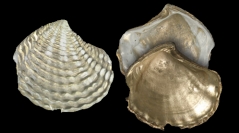

 Zoosystema
40 (7) - Pages 123-142
Zoosystema
40 (7) - Pages 123-142Rare species of three long-lived lucinid genera, Gibbolucina Cossmann, 1904, Barbierella Chavan, 1938 and Retrolucina n. gen., with origins in the Paleocene and Eocene of western Tethys, are present in the Mozambique Channel area of the southwestern Indian Ocean but absent elsewhere in the Indo-West Pacific. A new species, Gibbolucina zelee n. sp., is described from the Banc de la Zélée and western Madagascar that resembles Miocene species from western France. Since their origin in the Paleocene to the present day Barbierella species have always been rare. New records and images, including syntypes, are provided for Barbierella louisensis (Viader, 1951) from Mauritius and the Mozambique Channel, with Barbierella scitula Oliver & Abou-Zeid, 1986 from the Red Sea regarded as synonym. A new genus, Retrolucina n. gen., is proposed with the living Lucina voorhoevei Deshayes, 1857 (usually called Eomiltha voorhoevei) as type species and also including Lucina defrancei Deshayes, 1857, a strikingly similar species from the Eocene of the Paris Basin. Retrolucina n. gen. differs from Eomiltha Cossmann, 1912 in shape, sculpture and hinge characters. Monitilora Iredale, 1930, another genus of Paleocene or earlier origins, includes a few living species in the Indo-West Pacific and is now identified from Mozambique with Monitilora sepes (Barnard, 1964) (formerly Phacoides sepes Barnard, 1964). It is suggested that Gibbolucina, Barbierella and Retrolucina n. gen. species became isolated in the western Indian Ocean following the closure of the Tethyan Seaway in the early Miocene while their congeners in western Tethys became extinct. The survival of these rare genera, with restricted geographical ranges and seemingly small populations, runs counter to current ideas concerning long-term extinction risk.
Mollusca, Mozambique Channel, new combination, new genus, new species.